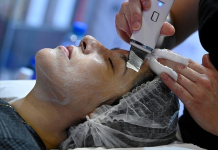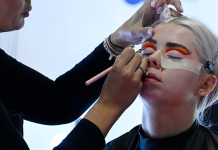Revealing New Skin
Skin peels have become increasingly popular among clients as they discover the great results that can be had from the relatively quick treatment – but with at-home kits becoming increasingly effective, how can salons set themselves apart?

Gone are the days when exfoliation was just a quick step after cleansing in a standard facial. Now the desire to get rid of dead skin cells and reveal new, brighter skin has become a real passion for many clients, resulting in the science behind skin peels to advance hugely in the last few years.
“Peels are also known as chemical exfoliation using glycolic acid, lactic acid, salicylic acid and mandelic acid,” explains Clare O'Hanlon, Business Development Manager at Juliette Armand Ireland. “These types of peels treat the superficial layer of the skin known as the epidermis. There we see fine lines forms, pigmentation and sun spots, pitting from old acne, scars old and new, blotches and dullness. These peels are great for instantly brightening the top layer of the skin whilst smoothing all the concerns mentioned. Peels can be quite tingly on the skin and range in different percentages and strengths. They are also known as AHAs and BHAs, which are a mixture of the acids together.”
Different acids have different effects, as Clare explains. “Glycolic acid comes in different strengths and pH, which will determine how deep it goes into the skin. This peel best treats wrinkles and sun damage; it is also the most ‘aggressive' peel as the molecules are the smallest and penetrate quicker, so the results tend to be the best and the side effects would be more exaggerated than the other peels, ie Intense tingling and redness"
“Lactic acid is more gentle and is best for dry, rosacea and sensitive skins, and as it is derived from milk it best suits older, thinner skin. Salicylic acid penetrates deeper into the oil glands so is best for oily and acne skins. Out of all the peels available, salicylic is your go-to peel for blackheads, milia, scabs, breakouts. Any blemishes tend to go ‘cloudy' and white, which means they are starting to heal rapidly.
“Mandelic acid is the most versatile as it can be used on any skin type and condition and colour (dark skin), which is contraindicated with the other peels. The molecules are quite large and so the feeling of tingle, redness and downtime is very minimum. Mandelic is derived from nut but the synthetic form so is suitable for nut allergies. It is best to start with lower percentages of the peels named and work your way to
stronger percentages for best result.”
Peels are not the only weapon in a therapist's armour when it comes to revealing brighter skin, as Victoria Schofield, Education Executive at Dermalogica, explains: “Exfoliating, resurfacing, peeling and micro-dermabrading are all various ways in which in the professional skin therapist can improve skin texture, tone and clarity and significantly impact challenging skin conditions such as acne, ageing and pigmentation.”
Going deeper
It is now possible to purchase an at-home peel product – and thanks to advances in the industry, many of these are extremely effective. So does this mean that more people are going for the cheaper homecare option over the salon treatment? Not so – simply because a well-trained and experienced therapist can tailor a peel to get results that an at-home treatment simply cannot compete with.
“Clients can now get their hands on pretty advanced formulas for home use,” says Victoria Schofield, “so it's important the skin therapist is able to offer something stronger in order to attract today's consumer that is looking for significant results.
“Some exfoliants, even scrubs, can be considered ‘very superficial', as they only affect the outermost stratum corneum. The term ‘peel' implies a deeper result, but the substances used, their concentration and pH, plus how long they're left to process, will all impact results. The health of the skin being worked also impacts results; the healthier and more hydrated the skin, the more tolerant it will be to treatment and adverse reactions minimised.
“A professional skin therapist is typically permitted to only remove keratinised (dead) skin tissue and not to remove live skin tissue. If you are working under medical supervision, your scope of practice may vary slightly. Advanced training qualifications may be needed for certain peels and the relevant insurance.”
Peels are classified according with how deep they penetrate the skin, as Victoria explains. “Very superficial depth refers to exfoliation or peels that affect the stratum corneum and above, but does not cause wounding below the stratum granulosum. Superficial depth refers to exfoliation or peels that affect various layers of the epidermis and above without going beyond the basal layer. Medium depth will affect as low as the papillary dermis and the above skin layers. Deep depth refers to peeling that removes the papillary dermis and can reach to the reticular dermis. Medium to deep peels are typically carried out in a medical setting.”
The knowledge and experience of a skilled skin therapist can really benefit the client when it comes to skin resurfacing treatments and peels. Specifically, a therapist can assess a client's skin, suggest treatment to prepare the skin for the treatment, and most importantly, choose the level of treatment that will have the biggest impact without compromising the skin's overall health.
“Our approach to peels at Dermalogica is to ensure maximum skin impact with as little trauma as possible,” says Victoria. “Rather than the traditional harsh degreasing step, we look to degrease the skin without compromising barrier health, this ensures skin response to acids is well tolerated. We also keep true to our customisation philosophy and have
the ability to tailor the peeling service to the skin condition and client's needs, rather than a ‘one size fits all' approach. This is achieved via thorough consultation and skin analysis that would include advice to condition and prime the skin before commencing peeling services to ensure positive skin outcomes. We also focus heavily on client after care and advice to minimise potential for negative responses.”
Benefits & warnings
The big advantage of peels is that it's a quick treatment that gives almost instant results. “Overall the benefits of peels are positive and the changes to the skin concerns are dramatic and instant,” explains Clare O'Hanlon. “Everyone over the age of 30 should be getting peels done in the salon to prevent deep wrinkles from forming and pigmentation getting darker. In order to keep the skin looking fresh and even toned, your client must always use SPF after a peel or they may experience
more pigmentation.”
But with such an effective treatment, there are some downsides. Not everyone is suitable for a peel. IMAGE Skincare is a leader in the skin peel industry, and the Irish head trainer, Caroline Casey, has the following advice:
“Salon peels contain a higher concentration of active ingredients and lower the pH of the skin, thus delivering a deeper treatment to achieve optimum results quickly. Clients must have a healthy skin barrier therefore must not be severely dehydrated nor inflamed.
Some examples of contraindications include:
• The use of Isotretinoin (Accutane) in the past 6 to 12 months
• Use of prescription topical keratolytics in the past seven days
• Retin A, Renova, Azelex, Tazorac, Differin etc…
• Use of prescription topical keratolytics in the past seven days
• Current use of Hydrocortisone
• Known allergies to ingredients of peels
• Currently under the supervision of a dermatologist for a skin disorder
• Autoimmune disorders
• Sunburn
• Active facial rashes
• Active cold sores (Herpes Simplex)
• Open lesions of the face”
Some ingredients are not suitable for certain conditions, for example, a therapist must assess a pregnant client carefully as many acids may not be suitable.
Training is essential for a therapist when it comes to peels as these are serious skin treatments that deliver serious results. Most brands offer specific training or there are continuing education courses available too. “You can never have enough training,” says Caroline. “We encourage ongoing and refresher training for all therapists working with skin and peels. We highly recommend continued education with CPD courses such as Sally Durant Advanced Skin Science to have a more inclusive
approach and thorough understanding. This is an online course provided by Renaissance Aesthetic Institute in Howth, Co. Dublin.”
For those therapists willing to put in the hours into training, there are plenty of rewards to be had, as peels are recommended as courses of treatments – and therefore excellent for attracting and keeping new clients. “Typically, you would need a course of three to six peels or resurfacing treatments given once a week or every other week, depending on skin recovery,” says Victoria. “It's important to compact the treatments for best results and homecare advice is paramount for successful outcomes. During a series of treatments, clients should not exfoliate at home 72 hours pre and post treatments and possibly up to 7-10 days depending on their level of sensitivity. This includes use of retinol. Very tolerant skins may use mild exfoliants in between treatments. UV exposure must be avoided two weeks pre- and post-treatments and high SPF (50+) worn daily. The risk for hyper-pigmentation post peeling is increased and skin barrier is reduced thus is natural protection. Consider promoting peels from autumn to spring
when it's easier to avoid UV exposure.”
“At IMAGE we advise clients to prep their skin with specific prepping products two weeks prior to their treatment,” says Caroline. “We also advise clients to not have any other treatments done within those two weeks such as microneedling or laser. On the week of their appointment clients should avoid waxing on the face, and direct sunlight. The same verbal advice is given after a treatment and clients receive a post-treatment kit with products to aid the skin barrier to heal faster, which clients use for five days post treatment. SPF is a MUST!”
A final word about SPF and the sun from Danné Montague King, creator of the DMK product range and peeling systems: “After a chemical peel, the layers of new skin underneath are unprotected and therefore highly susceptible to damage by the sun and other environmental factors such as bacteria that could cause infection.
“Exposure to the sun after a chemical peel can result in pigmentation problems such as age spots or severe solar damage to the skin and even skin cancer. Pigmentation problems occur because excess melanin (skin pigment) rushes to the surface to protect the skin when it is seen to be under threat. Therefore protection from the sun using DMK Transdermal Sunblock is strongly recommended following any skin treatment.”
Address Book
Several brands offer professional peeling systems, including the following:
Juliette Armand – Boost Beauty Solutions: 01 490 5525
Dermalogica: www.dermalogica.ie
IMAGE Skincare – Renaissance Skincare: 01 832 1412
Dr Irena Eris – Skincare PRO: 01 555 1878
Ericson Laboratoire – Hennessy Hair & Beauty: 021 434 3436
DMK – Chleo Enterprises: 01 408 0820
AFA Peels – Eden Beauty Group: 0404 612 95






